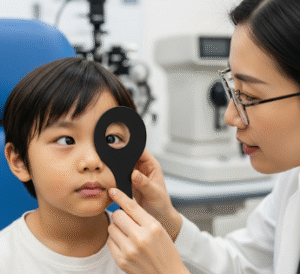Overview
Acanthamoeba infection is a rare but serious condition caused by a microscopic, free-living amoeba found in soil, water, and air. It can affect the eyes, skin, and central nervous system. Eye infections, particularly in contact lens wearers, are the most common. When it reaches the brain, it can cause a life-threatening condition known as granulomatous amoebic encephalitis (GAE). Early diagnosis and aggressive treatment are critical.
What is Acanthamoeba Infection?
Acanthamoeba infection is caused by the Acanthamoeba species, which are tiny organisms that naturally exist in the environment. This amoeba can enter the human body through the eyes, broken skin, or inhalation. Once inside, it may lead to:
- Acanthamoeba keratitis (eye infection)
- Granulomatous amoebic encephalitis (brain infection)
- Disseminated infection (skin and other organs)
This infection is especially dangerous for people with weakened immune systems but can also occur in healthy individuals.
Symptoms
Acanthamoeba Keratitis (Eye Infection):
- Eye pain
- Redness
- Blurred vision
- Sensitivity to light
- Excessive tearing
- A feeling of something in the eye
Granulomatous Amoebic Encephalitis (GAE):
- Headache
- Stiff neck
- Nausea and vomiting
- Fatigue
- Confusion
- Seizures
- Hallucinations
- Loss of coordination
Skin Infections:
- Non-healing skin ulcers
- Nodules or abscesses
- Skin redness and swelling
Causes
The infection is caused by Acanthamoeba, a free-living amoeba found in:
- Tap water
- Swimming pools and hot tubs (especially poorly maintained)
- Soil and dust
- Contact lens solution (especially if contaminated)
- Lakes and rivers
Poor hygiene practices, particularly among contact lens users, significantly increase the risk.
Risk Factors
- Wearing contact lenses (especially overnight or with poor hygiene)
- Using homemade saline or contaminated contact lens solution
- Swimming, bathing, or using hot tubs while wearing contact lenses
- Having open wounds exposed to contaminated water or soil
- Weakened immune system (HIV/AIDS, cancer, organ transplant recipients)
- Existing eye trauma or corneal damage
Complications
If left untreated, Acanthamoeba infection can lead to:
- Permanent vision loss or blindness (from keratitis)
- Scarring of the cornea
- Brain infection (GAE), which is often fatal
- Widespread infection in immunocompromised patients
- Delayed diagnosis due to symptom similarity with other conditions
Prevention
- Always wash hands before handling contact lenses
- Never use tap water to rinse or store lenses
- Disinfect lenses with commercially prepared solutions
- Avoid swimming, hot tubs, or showering while wearing lenses
- Regularly replace contact lens cases and keep them clean
- Protect open wounds from soil and untreated water
- Boost immunity and manage chronic illnesses carefully
Treatment Options in korea
Treatment depends on the type and severity of the infection:
For Acanthamoeba Keratitis:
- Topical antiseptics (chlorhexidine, polyhexamethylene biguanide)
- Antifungal eye drops
- Antibiotic or antiviral eye drops (in some cases)
- Pain management
- In severe cases, corneal transplant surgery may be required
For Granulomatous Amoebic Encephalitis (GAE):
- Combination therapy including antifungals (e.g., fluconazole), antiparasitic drugs (miltefosine), and antibiotics
- Intensive care and hospitalization
- Experimental therapies (due to high fatality rate and lack of standardized treatment)
For Skin Infections:
- Antimicrobial therapy
- Surgical removal of infected tissue
- Management of underlying immune conditions













